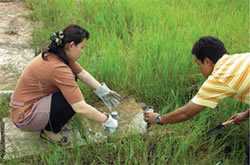Global Disease Detection Program: Thailand

CDC’s Global Disease Detection Regional Center in Thailand built laboratory capacity across seven countries, enabling them to conduct new tests and respond more effectively to infectious disease threats.
The U.S. Centers for Disease Control and Prevention (CDC) has worked with the Ministry of Public Health (MOPH) and other key institutions in Thailand since 1980 to address the major public health challenges of the country, and increasingly, in Southeast Asia and beyond. These MOPH partnerships have produced a world renowned field epidemiology training program, effective strategies to curtail and contain HIV transmission, and vital international responses to severe acute respiratory syndrome (SARS) and the continued threats of avian and pandemic influenza.
In 2004, CDC established a Global Disease Detection (GDD) Regional Center to better meet the complexity of emerging infectious diseases in Thailand and the Asia-Pacific region. The Center builds upon established World Health Organization (WHO) and CDC presence, MOPH expertise, and a strong partner base.
The Center in Thailand is headquartered at the MOPH campus near Bangkok. Principal partners include the MOPH and Ministry of Agriculture and Cooperatives, WHO regional offices in Southeast Asia and the Western-Pacific, major academic institutions, multilateral organizations, U.S. government agencies and nongovernmental institutions.
Responding to Health Threats
Together with partners, the Center helps Thailand and Southeast Asia detect and respond to serious public health threats ranging from influenza and tuberculosis to zoonotic and vector-borne diseases such as anthrax, brucellosis, dengue, malaria, and Nipah and chikungunya viruses.

Scientists working with the GDD Center in Thailand collect soil samples to evaluate the environment as a reservoir for unusual types of Legionella, which have been detected as a cause of hospitalized pneumonia through the surveillance and research activities.
Building Disease Detection and Response Capacity
Using the International Health Regulations (2005) as an organizing framework, the Center links the strengths of overseas CDC programs with country and regional partners – relying on local rather than remote resources.
The Center’s integrated approach helps reduce detection and response time by developing sustainable regional capacity in:
- Emerging infectious disease detection and response
- Field epidemiology and laboratory training
- Pandemic influenza preparedness and response
- Laboratory systems and biosafety
- Zoonotic disease research and control
- Health communications and information technology
Connecting Resources
The Center engages its partner network to harmonize strategies and leverage resources to improve detection and response to emerging infectious diseases. In 2009, Center expertise was used to develop a comprehensive training curriculum for respiratory infection control and prevention, integrating WHO and CDC infection control guidelines for influenza, acute respiratory infections, and tuberculosis. Through GDD’s network, the curriculum developed in Thailand has been shared globally.
Making a Regional Impact

As part of the One Health Initiative, scientists working in collaboration with the Global Disease Detection Center in Thailand are investigating bats as a potential reservoir for human pathogens.
From 2006-2015, the Center in Thailand has supported:
- Effective response to 78 outbreaks, at the invitation of WHO and affected countries
- Ongoing disease surveillance activities covering 1.2 million people
- Establishment of laboratory diagnostic testing capacity for 45 pathogens
- Detection of 18 pathogens new to the region, three of which are new to the world
- Graduation of 95 future global health leaders from six countries as part of the two-year Field Epidemiology Training Program
- Training of nearly 20,000 public health officials from over 20 countries in short term public health exercises, including emergency preparedness, epidemiology, and laboratory diagnostics and biosafety
- Development and implementation of WHO-endorsed standardized teaching curricula for Pandemic Rapid Response and Outbreak Investigations
- Page last reviewed: April 4, 2016
- Page last updated: April 4, 2016
- Content source:


 ShareCompartir
ShareCompartir